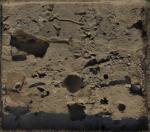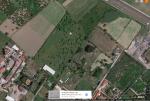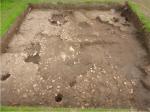Summary (English)
Three trenches were opened during the 2016 campaign undertaken by the University of Salerno in the Archaeological Park of Pontecagnano with the aim of following the development of the structures along the NE/SW road uncovered during previous excavations.
The excavations were integrated by a geomagnetic survey that revealed the presence of probable structures.The first trench (Trench 3: 7 × 6 m) constituted the extension towards the north-west of Trench 1 of 2015 – of which a 2 m wide sector was reopened – corresponding with the strip immediately north-west of the road. Once the humus was removed, the post 79 A.D. agricultural soil emerged, characterised by the widespread presence of Vesuvian pumice stone, in which numerous planting pits, trenching, furrows and channels were cut that related to agricultural activity in the modern and contemporary periods. Evidence relating to medieval occupation was found in this ground surface: a silo that seemed to be situated inside an area defined by postholes on the east side.
The post 79 A.D. agricultural layer obliterated at least two construction phases indicated by walls of travertine blocks aligned on the edge of the road. The excavation halted at the crest of the walls, the stratigraphic sequence, and chronology of the buildings will be investigated during the next campaign. At present, the latest level of the road, which overlay several earlier ones, can be dated to the late 3rd century B.C.
In Trench 4 (10 × 5m), situated south-east of the road, the stratigraphy was compromised by razing that had occurred in antiquity. The excavation halted at a substantial layer of travertine 60-70 cm deep overlying a palaeo-surface reached in a test pit. Pits were present in the travertine, filled with soil mixed with travertine fragments, perhaps relating to the quarrying of this material for construction use. The materials recovered from these pits was mainly constituted by fragments of coarse ware pottery which was not much use for dating purposes; the few fragments of black glaze ware dated to between the 4th and 3rd century B.C.
There were distinct alignments of travertine scraps and fragments that could constitute the residue from the foundations of a rectangular building, at a right angle to the road. A few tile fragments, wall sherds from large containers and fragments of coarse ware were recovered from these presumed foundations. They were not very diagnostic but seem similar to 5th century productions rather than later ones.
A small channel with parapets made of travertine chips ran along the north-eastern side of the building and led into a channel that formed the edge of the road. The materials from the fill of the small channel (US 07058) can be generically dated to between the 4th and 3rd century B.C.
The channel at the edge of the road was covered by a dump of gravel and tile overlying the occupation layers and fill.Trench 5 (6 × 3 m) was opened in order to check the intermediate area between Trench 4 and the residential building excavated by the University of Molise. The excavations halted at a compact layer of clay that to the north-west obliterated the latest road level, visible in the numerous holes caused by root growth. A large rectangular travertine block (80 x at least 120 cm) was situated on top of this layer, but was not aligned with the road or structures. Its function and chronology will be investigated during the next campaign.
- Carmine Pellegrino (Dipartimento di Scienze del Patrimonio Culturale – Università di Salerno)
Director
- Carmine Pellegrino - Dipartimento di Scienze del Patrimonio Culturale – Università di Salerno
Team
- Annarita Russo (Dipartimento dCulturale – Università di Salernoi Scienze del Patrimonio )
- Valeria Petta (Dipartimento di Scienze del Patrimonio Culturale – Università di Salerno)
- Antonella Massanova (Dipartimento di Scienze del Patrimonio Culturale – Università di Salerno)
Research Body
- Università degli Studi di Salerno






![Download [PDF]](/excavation/skins/fasti/images/results/download_sml.png)


